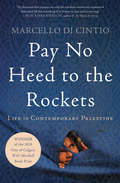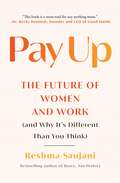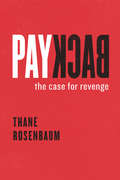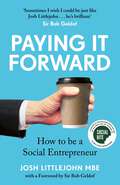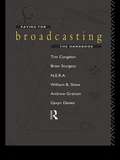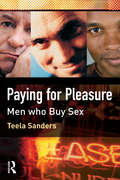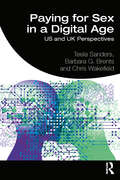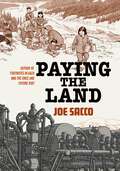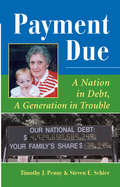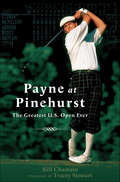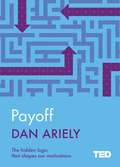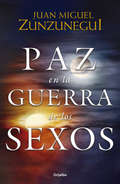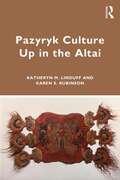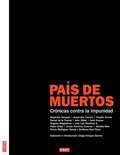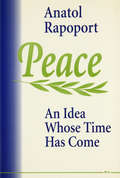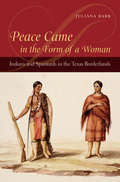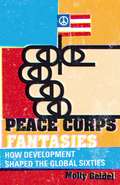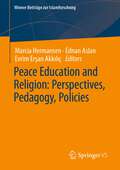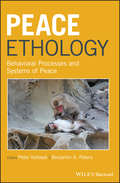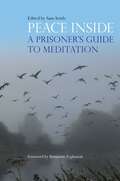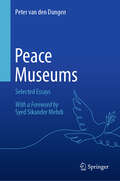- Table View
- List View
Pay No Heed to the Rockets: Life in Contemporary Palestine
by Marcello Di Cintio"With humility, respect, and great sensitivity, he seeks out writers, people skilled at telling stories, and asks them to narrate their own situations. The result is a document that captures not only the manifold sorrows and injustices of Palestinian life but something of its beauty, its joys, and its yearning." —Ben Ehrenreich, author of The Way to the Spring Taking the long route through the West Bank, into Jerusalem, across Israel, and finally into Gaza, Marcello Di Cintio meets with Palestinian poets, authors, librarians, and booksellers to learn about Palestine through their eyes. Pay No Heed to the Rockets offers a look at life in contemporary Palestine through the lens of its literary culture, one that begins with art rather than with war.
Pay Up: The Future of Women and Work (and Why It's Different Than You Think)
by Reshma SaujaniThe founder of Girls Who Code and bestselling author of Brave, Not Perfect confronts the &“big lie&” of corporate feminism and presents a bold plan to address the burnout and inequity harming America&’s working women today.We told women that to break glass ceilings and succeed in their careers, all they needed to do is dream big, raise their hands, and lean in. But data tells a different story. Historic numbers of women left their jobs in 2021, resulting in their lowest workforce participation since 1988. Women&’s unemployment rose to nearly fifteen percent, and globally women lost over $800 billion in wages. Fifty-one percent of women say that their mental health has declined, while anxiety and depression rates have skyrocketed. In this urgent and rousing call to arms, Reshma Saujani dismantles the myth of &“having it all&” and lifts the burden we place on individual women to be primary caregivers, and to work around a system built for and by men. The time has come, she argues, for innovative corporate leadership, government intervention, and sweeping culture shift; it&’s time to Pay Up. Through powerful data and personal narrative, Saujani shows that the cost of inaction—for families, for our nation&’s economy, and for women themselves—is too great to ignore. She lays out four key steps for creating lasting change: empower working women, educate corporate leaders, revise our narratives about what it means to be successful, and advocate for policy reform. Both a direct call to action for business leaders and a pragmatic set of tools for women themselves, Pay Up offers a bold vision for change as America defines the future of work.
Payback: Debt and the Shadow Side of Wealth (The CBC Massey Lectures)
by Margaret AtwoodAvailable in a new edition and with an introduction by Margaret Atwood, Payback delivers a surprising look at the topic of “debt” — a subject that continues to be timely.Legendary novelist, poet, and essayist Margaret Atwood delivers a surprising look at the topic of “debt” — a subject that continues to be timely during this current period of economic upheaval. In her intelligent and imaginative approach to the subject, Atwood proposes that “debt” is like air — something we take for granted and never think about until things go wrong.This is not a book about practical debt management or high finance, although it does touch upon those subjects. Rather, it goes far deeper into an investigation of debt as a very old, very central motif in religion, literature, and the structure of human societies. By looking at how debt has informed our thinking from preliterate times to the present day, through the stories we tell to our concepts of “revenge” and “sin” to the way we structure our social relationships, Atwood shows that this idea of what we owe — in other words, “debt” — is possibly built into the human imagination as one of its most dynamic metaphors. In the final section, Atwood touches upon not only our current global financial situation, but also the concept of our “debt to nature” and how our ideas of ownership and debt must be changed if we are to find a new way to interact with our natural environment.
Payback: The Case for Revenge
by Thane RosenbaumWe call it justice--the assassination of Osama bin Laden, the incarceration of corrupt politicians or financiers like Rod Blagojevich and Bernard Madoff, and the climactic slaying of cinema-screen villains by superheroes. But could we not also call it revenge? We are told that revenge is uncivilized and immoral, an impulse that individuals and societies should actively repress and replace with the order and codes of courtroom justice. What, if anything, distinguishes punishment at the hands of the government from a victim's individual desire for retribution? Are vengeance and justice really so very different? No, answers legal scholar and novelist Thane Rosenbaum in Payback: The Case for Revenge--revenge is, in fact, indistinguishable from justice. Revenge, Rosenbaum argues, is not the problem. It is, in fact, a perfectly healthy emotion. Instead, the problem is the inadequacy of lawful outlets through which to express it. He mounts a case for legal systems to punish the guilty commensurate with their crimes as part of a societal moral duty to satisfy the needs of victims to feel avenged. Indeed, the legal system would better serve the public if it gave victims the sense that vengeance was being done on their behalf. Drawing on a wide range of support, from recent studies in behavioral psychology and neuroeconomics, to stories of vengeance and justice denied, to revenge practices from around the world, to the way in which revenge tales have permeated popular culture--including Hamlet, The Godfather, and Braveheart--Rosenbaum demonstrates that vengeance needs to be more openly and honestly discussed and lawfully practiced. Fiercely argued and highly engaging, Payback is a provocative and eye-opening cultural tour of revenge and its rewards--from Shakespeare to TheSopranos. It liberates revenge from its social stigma and proves that vengeance is indeed ours, a perfectly human and acceptable response to moral injury. Rosenbaum deftly persuades us to reconsider a misunderstood subject and, along the way, reinvigorates the debate on the shape of justice in the modern world.
Paying It Forward: How to be a Social Entrepreneur
by Josh LittlejohnA Social Change Book for Those Committed to Putting People Before ProfitJosh Littlejohn MBE, Scottish social entrepreneur, London Sunday Times bestselling author, and campaigner for the homeless, opens eyes to the need for positive socio-cultural impact within the world of business.More than a business book.Paying It Forward is part memoir, part manifesto for social entrepreneurship, and part manual for putting purpose ahead of profit. The book reveals what social entrepreneurship is all about and how it can make a difference. Take a look into the social issues that affect our communities today and how we can do our part in making the world a better place.Social change starts with one person. Josh found his way in the world of business when he opened a sandwich shop in his home city of Edinburgh, Scotland. He would never have thought that within ten years the shop would be frequented by Hollywood megastars, that he would have opened a string of successful cafés across the UK, and that he would be honored with an MBE Order of the British Empire award by Queen Elizabeth.A life purpose of service. Josh’s dedication to social entrepreneurship was set in motion when a homeless person named Pete walked into his café and sheepishly asking for a job. Pay it Forward tells Josh’s story of success in business and how you can begin your own journey to social entrepreneurship.Inside learn:What it means to be successful while still putting people before profitHow to become a community helper and create a positive socio-cultural impactHow to look at social issues in your own community and answer the question: “What would a social entrepreneur do?”If you liked books such as Social Change Now, The Little Book of Nonprofit Leadership, or Change: How to Turn Uncertainty Into Opportunity, you’ll love Paying It Forward.
Paying for Broadcasting: The Handbook
by Tim Congdon Andrew Graham Gavyn Davies William B. Shew Brian SturgessFirst published in 2004. Routledge is an imprint of Taylor & Francis, an informa company.
Paying for Pleasure: Men Who Buy Sex
by Teela SandersDrawing on original empirical data with men who buy sex, this book takes a fresh look at the relationships clients have with female sex workers. The core questions that form the backbone of the research are not only the expected inquiry into 'why men buy sex', but also into the sociological and psychological processes that men encounter in order to enter an assumed 'deviant' sexual behaviour as part of their everyday lives. These sociological processes of finding, negotiating and buying sexual services are complicated by the stigma directed towards men who buy sex. Exactly how do men behave with sex workers; what are their relationships like; what emotions are involved and can intimacy be bought? Questioning the dichotomy made between commercial and non-commercial relationships, the data suggests that intimacy and commerce are compatible. Managing secrecy, stigma and the consumption of intimacy takes this book into some of the more challenging theoretical areas of masculinity and emotional consumption in contemporary society. Drawing some parallels from the author's earlier book Sex Work: A Risky Business, the book offers insights into why engagement in commercial sex is prolific as sexual culture is transformed in late modernity.
Paying for Progress in China: Public Finance, Human Welfare and Changing Patterns of Inequality (Routledge Contemporary China Series #Vol. 21)
by Vivienne Shue Christine WongChina’s stunning record of economic development since the 1970s has been marred by an increasingly obvious gap between the country’s ‘haves’ and its ‘have-nots’. While people living in some parts of the country have enjoyed dramatically improved conditions of life, those in other districts and regions have slipped ever further behind in terms of access to health, wealth, education, security and opportunity. Paying for Progress in China is a collection of essays which trace the causes of this growing inequality, using new data including surveys, interviews, newly available official statistics and in-depth fieldwork. Their findings expose the malfunctioning of China’s ‘broken’ intergovernmental fiscal system, which has exacerbated the disequalizing effects of emerging market forces. Whilst the government’s deliberately ‘pro-poor’ development policies have in recent years sought to reduce the gap between rich and poor, both markets, and also state institutions and policies, are continuing to create perverse equity outcomes across the country, confounding hopes for better-balanced and more inclusive growth in China. The interdisciplinary approach of this collection, incorporating work by economists, sociologists and political scientists, makes it a valuable resource for students of contemporary Chinese political economy and social development.
Paying for Sex in a Digital Age: US and UK Perspectives
by Teela Sanders Barbara G. Brents Chris WakefieldProviding one of the first comprehensive, cross-cultural examinations of the dynamic market for sexual services, this book presents an evidence-based look at the multiple factors related to purchasing patterns and demand among clients who have used the internet. The data is drawn from two large surveys of sex workers’ clients in the US and UK. The book presents descriptive baseline data on client engagement with online platforms, demographics and patterns of frequency in different markets, information on smaller niche markets and client reactions to exploitation, safety and changes in the law. The book makes clear that a variety of situational as well as individual factors affect the willingness and ability to purchase sexual services. The view that emerges shatters the stereotypes and generalistions on which much policy is based and demonstrates the complexities surrounding who pays for sex and the contours of sexual consumption in consumer culture.
Paying the Land
by Joe SaccoNAMED A BEST BOOK OF 2020 BY THE NEW YORK TIMES, THE GUARDIAN, THE BROOKLYN RAIL, THE GLOBE AND MAIL, POP MATTERS, COMICS BEAT, AND PUBLISHERS WEEKLYFrom the “heir to R. Crumb and Art Spiegelman” (The Economist), a masterful work of comics journalism about indigenous North America, resource extraction, and our debt to the natural worldThe Dene have lived in the vast Mackenzie River Valley since time immemorial, by their account. To the Dene, the land owns them, not the other way around, and it is central to their livelihood and very way of being. But the subarctic Canadian Northwest Territories are home to valuable resources, including oil, gas, and diamonds. With mining came jobs and investment, but also road-building, pipelines, and toxic waste, which scarred the landscape, and alcohol, drugs, and debt, which deformed a way of life.In Paying the Land, Joe Sacco travels the frozen North to reveal a people in conflict over the costs and benefits of development. The mining boom is only the latest assault on indigenous culture: Sacco recounts the shattering impact of a residential school system that aimed to “remove the Indian from the child”; the destructive process that drove the Dene from the bush into settlements and turned them into wage laborers; the government land claims stacked against the Dene Nation; and their uphill efforts to revive a wounded culture.Against a vast and gorgeous landscape that dwarfs all human scale, Paying the Land lends an ear to trappers and chiefs, activists and priests, to tell a sweeping story about money, dependency, loss, and culture—recounted in stunning visual detail by one of the greatest cartoonists alive.
Payment Due: A Nation In Debt, A Generation In Trouble
by Timothy J PennyTodays children and grandchildren are tomorrows taxpayers and social fabric, and this book contends that we are setting them up for economic disaster with our current policies of federal overspending. Former Representative Tim Penny (DMinn.) and political scientist Steven Schier take us inside the Capitol to show us the lobbying, arm twisting, and pork barreling that goes on to derail policies designed to reduce the federal deficit; and they offer students the opportunity to try out short- and long-term solutions, to better understand and confront the political, social, and moral payments now coming due. }The generational wars are about to begin: competing for entitlements, wrestling over taxes, dancing around the deficit. Todays children and grandchildren are tomorrows taxpayers and social fabric. The authors of Payment Due contend that we are setting those children up for economic disaster. Former Representative Tim Penny (DMinn.) knows how volatile the politics of the situation are; he retired because he couldnt locate in Congress at large the institutional will (or stomach) to deal with the issues squarely. Political scientist Steven Schier understands the way in which the politics work against economics to solve the problem. Together, they take us inside the Capitol corridors to show us the lobbying, arm twisting, and pork barreling that goes on to derail policies designed to reduce the federal deficit. We get to play the Washington Monument game along with the worst of the offenders and to see firsthand how three schools of deficit thoughtthe wolves, pussycats, and termiteseach approach the prospect of cutting back federal outlays and weaning the great middle class from its own welfare dependency.A hallmark of the book is its three-tiered set of long-term entitlement reform proposals, complete with careful documentation of the contribution each recommended item makes toward reducing the federal deficit (or at least slowing its increase). Along with suggested short-term plans, these proposals give students the opportunity to try to solve both short- and long-term problems. Students will appreciate the timeliness and relevance of the books argument to their generations future plight, and all readers will benefit from the clear presentation of complex economic concepts and arguments essential to understanding the federal deficit debateand to confronting the political, social, and moral payments now coming due.
Payne at Pinehurst: The Greatest U.S. Open Ever
by Bill ChastainPayne at Pinehurst presents a fascinating re-telling of the 1999 U.S. Open--considered by many golf experts as the greatest U.S. Open ever played--where Payne Stewart dramatically sunk a fifteen-foot putt on the 18th hole to defeat Phil Mickelson, Tiger Woods, and a host of other golf greats just four months before his untimely death in a bizarre plane crash.It has been called the greatest U.S. Open in the Open's over one hundred-year history.Veteran sports journalist, Bill Chastain, crafts the dramatic story of Payne Stewart's 1999 U.S. Open victory by combining extensive research with interviews of those who made it unique. Payne at Pinehurst shows how Stewart dealt with his stunning U.S. Open defeat in 1998 and planned victory for the championship that meant so much to him.Stewart's conquest of Pinehurst No. 2, while fending off Phil Mickelson, Tiger Woods, David Duval, and Vijay Singh in an epic battle where every swing held significance, is the stuff of which golf legends are made. From compelling action by the best golfers in the world to the tournament's dramatic conclusion, Payne at Pinehurst shows readers why the 1999 U.S. Open is regarded as the best U.S. Open ever played."A fresh and concise look at Payne Stewart's victory at the 1999 U.S. Open."--Golf Digest
Payoff: The Hidden Logic That Shapes Our Motivations (TED 2)
by Dan ArielyEvery day we work hard to motivate ourselves. We spend much of our time trying to motivate the people working for us, with us and in business with us. In our personal lives we try to motivate our friends, partners and children. From the economic point of view, motivation is based on a very simple trade-off: we need and want things, and we work to get them. We're more likely to do something if we get money for it, and the more money we get, the more motivated we are. But what if our understanding of motivation and money is all wrong? In Payoff, Dan Ariely investigates the true nature of motivation and our partial blindness to the way it works. He digs to the root of money motivation, and explains how understanding it can help us to successfully approach different choices in our lives. Along the way, Ariely explores complex questions like: * Why are we willing to part with money on some occasions and not others? * Should we motivate children to do chores by giving them money? * Is there any correlation between performance efficiency and pay? * What are the taboos surrounding money and should they be challenged? We often, mistakenly, think that our motivations are simple and one dimensional. But motivations are about the essence of what pushes us forward, what make us human. Payoff explores the complex motivations that drive us, giving insight into what we really want in life and what we can do to get and give more of it more often.
Paz en la guerra de los sexos
by Juan Miguel ZunzuneguiLa historia del sexo es la historia de la humanidad en guerra contra sí misma. La guerra eterna entre lo masculino y lo femenino que marcó el origen y el devenir de la civilización, desde la revolución agrícola hasta la industrial, desde las antiguas mitologías hasta las estrategias de comunicación masiva, desde los tiempos lejanos en que la divinidad era mujer hasta la guerra de los dioses en que los hombres tomaron el poder. Paz en la guerra de los sexos es un viaje a través de la historia y del universo, desde las profundidades más místicas hasta las más mundanas. Una historia de la humanidad a través de la mitología y la religión, de la filosofía y la ciencia, sociología y psicología, meditación y misticismo, un viaje que comienza con la expulsión del paraíso y trata de indicarnos el camino de regreso.
Pazyryk Culture Up in the Altai
by Katheryn M. Linduff Karen S. RubinsonThis book reconsiders the archaeology of the Pazyryk, the horse-riding people of the Altai Mountains who lived in the 4th–3rd centuries BCE, in light of recent scientific studies and excavations not only in Russia but also Kazakhstan, Mongolia and China, together with new theories of landscape. Excavation of the Pazyryk burials sparked great interest because of their wealth of organic remains, including tattooed bodies and sacrificed horses, together with superb wooden carvings and colorful textiles. In view of this new research, the role of the Pazyryk Culture in the ancient globalized world can now be more focused and refined. In this synthetic study of the region, the Pazyryk Culture is set into the landscape using recent studies on climate, technology, human and animal DNA and local resources. It shows that this was a powerful, semi-sedentary, interdependent group with contacts in Eurasia to their west, and to their east in Mongolia and south in China. This book is for archaeologists, anthropologists, art historians, social and economic historians as well as persons with general interests in mobile pastoralism, the emergence of complex societies, the social roles of artifacts and the diverse nature of an interconnected ancient world.
País de muertos
by Diego Enrique OsornoUna estupenda colección de crónicas y reportajes sobre los muertos y la gente que claman por justicia en México, redactados por algunos de los periodistas más destacados de la actualidad: Emiliano Ruiz Parra, Pablo Ordaz, José Luis Martínez S, León Krauze, Arturo Rodríguez García, Alejandro Almazán, John Gibler, Daniel de la Fuente, Angeles Magdaleno, Daniela Rea, Froylán Enciso. La recopilación de los textos estuvo a cargo de Diego Enrique Osorno. Trece crónicas estremecedoras sobre la impunidad, escritas por algunos de los mejores periodistas mexicanos. El término "periodismo narrativo" suele ser visto con escepticismo y hasta con sorna en algunas redacciones donde, como dice Juan Villoro, los periodistas cada vez se hacen más gordos y los periódicos más flacos. En esos lugares "informar" puede consistir en sentarse a revisar el correo electrónico, descargar el boletín oficial (ya sea del gobierno, la ONG, el partido opositor o la empresa trasnacional), reescribirlo, preservando el mismo tono de rueda de prensa, producir una nota que hable con voz institucional y mantener así al periodismo dentro de la escenografía de la impunidad. "Narrar", por el contrario, requiere una presencia en el sitio donde suceden las cosas, aprender a escuchar, desarrollar una capacidad de observación de los pequeños detalles, tener una enorme concentración a la hora de contar la experiencia vivida y desafiar así, con el poder de la palabra, lo absurdo. No es lo mismo contar el número de muertos que contar las historias de nuestros muertos. Esta guía narrativa de la impunidad asesina en México fue hecha a partir de esa idea. La vida de hoy mata, los casos contados en este libro así lo demuestran. Nos estamos muriendo: las mujeres, los obreros, los niños, los narcos, los indígenas, los mineros, las maestras, los policías, los campesinos, los comerciantes, los periodistas, los profesores de ping-pong, los soldados, las estudiantes, los vivosy los muertos, que ya muertos, vuelven a morir otra vez, una y otra vez, a causa de la ausencia de justicia y el olvido. Las catorce crónicas de País de muertos no son parte de ninguna fosa común o de una sala del museo de los muertos. Conforman una de las antologías más plurales y representativas del periodismo narrativo y de investigación, si no es que ambos adjetivos salen sobrando y se debería hablar solamente de buen periodismo hecho en México.
País rico, país pobre: La Argentina que no miramos. Un propuesta para salir de la trampa de la pobreza
by Eduardo AmadeoUna detallada y extraordinariamente documentada descripción de lasituación actual del país divido en dos. Análisis de las causas yconsecuencias de la pobreza, y la propuesta de una agenda de solucionespara resolver lo que aparece como el drama más grave de la Argentina. Después de treinta años de crisis y empobrecimiento continuo, laArgentina es hoy un país dividido en dos. Por un lado, treinta millonesde personas pueden -con más o menos problemas- imaginar y construir unproyecto de vida pensando en el futuro. En el otro país, al menos cuatromillones de argentinos viven en la indigencia y sin esperanza alguna yotros seis millones sobreviven como pueden, pasando de la pobreza a laindigencia en función de las crisis económicas y los fluctuantes númerosde la inflación. Son diez millones los que comparten una educación pobrepara pobres: trabajo en negro que esclaviza y condiciones de vidadeplorables.Los que vivimos en el país de los treinta millones muchas veces tenemosdificultades para mirar y entender lo que les sucede a los del «otropaís». Prejuicios y temores nos hacen alejarnos, no querer escuchar eincluso recomendar soluciones represivas como única alternativa.
Peace
by Anatol RapoportIn Peace: An Idea Whose Time Has Come, noted mathematician and peace researcher Anatol Rapoport explores the evolution of the idea of peace and explains why it is displacing war as a viable institution. Professor Rapoport ventures into uncharted philosophical territory by drawing on both the natural and the social sciences to trace the development of the ideas of war and peace. He argues that the theory of evolution and processes analogous to natural selection can explain not only biological events, but also the development of the institution of war. Thus the clashes of armed hordes at the dawn of history were the “ancestors” of our present battles using automated weapons, while Isaiah’s prophecy of total disarmament—“And they shall beat their swords into ploughshares”—anticipates the resolutions of the United Nations. Rapoport explains that although the institution of war enjoys a long history and continues to be a policy option today, it may soon fall into disuse, either by losing its relevance to modern life or by destroying the civilizations that practice it. He then calls attention to ideas that lie dormant until people’s “ideational environment” becomes receptive to their germination: peace, Anatol Rapoport believes, is one such idea. Peace continues in the interdisciplinary tradition that has taken root in inquiries at the nexus of science and philosophy. No specific technical knowledge is expected of the reader, only a willingness to venture into little-charted areas of thought.
Peace Came in the Form of a Woman
by Juliana BarrRevising the standard narrative of European-Indian relations in America, Juliana Barr reconstructs a world in which Indians were the dominant power and Europeans were the ones forced to accommodate, resist, and persevere. She demonstrates that between the 1690s and 1780s, Indian peoples including Caddos, Apaches, Payayas, Karankawas, Wichitas, and Comanches formed relationships with Spaniards in Texas that refuted European claims of imperial control.Barr argues that Indians not only retained control over their territories but also imposed control over Spaniards. Instead of being defined in racial terms, as was often the case with European constructions of power, diplomatic relations between the Indians and Spaniards in the region were dictated by Indian expressions of power, grounded in gendered terms of kinship. By examining six realms of encounter--first contact, settlement and intermarriage, mission life, warfare, diplomacy, and captivity--Barr shows that native categories of gender provided the political structure of Indian-Spanish relations by defining people's identity, status, and obligations vis-a-vis others. Because native systems of kin-based social and political order predominated, argues Barr, Indian concepts of gender cut across European perceptions of racial difference.
Peace Corps Fantasies: How Development Shaped the Global Sixties (Critical American Studies)
by Molly GeidelTo tens of thousands of volunteers in its first decade, the Peace Corps was &“the toughest job you&’ll ever love.&” In the United States&’ popular imagination to this day, it is a symbol of selfless altruism and the most successful program of John F. Kennedy&’s presidency. But in her provocative new cultural history of the 1960s Peace Corps, Molly Geidel argues that the agency&’s representative development ventures also legitimated the violent exercise of American power around the world and the destruction of indigenous ways of life.In the 1960s, the practice of development work, embodied by iconic Peace Corps volunteers, allowed U.S. policy makers to manage global inequality while assuaging their own gendered anxieties about postwar affluence. Geidel traces how modernization theorists used the Peace Corps to craft the archetype of the heroic development worker: a ruggedly masculine figure who would inspire individuals and communities to abandon traditional lifestyles and seek integration into the global capitalist system.Drawing on original archival and ethnographic research, Geidel analyzes how Peace Corps volunteers struggled to apply these ideals. The book focuses on the case of Bolivia, where indigenous nationalist movements dramatically expelled the Peace Corps in 1971. She also shows how Peace Corps development ideology shaped domestic and transnational social protest, including U.S. civil rights, black nationalist, and antiwar movements.
Peace Education and Religion: Perspectives, Pedagogy, Policies (Wiener Beiträge zur Islamforschung)
by Ednan Aslan Marcia Hermansen Evrim Erşan AkkılıçWhether formally incorporated into curriculum and teacher training or informally integrated in contexts such as state or NGO initiatives dealing with resolving social, ethnic, and religious conflicts, peace education is increasingly recognized as a critical component in addressing violence in contemporary plural societies. Peace education can constructively undertake a reframing of historical narratives while inspiring practical community activities. An important, but insufficiently studied and theorized aspect of peace education is the role of religion. The challenge to peace education in today’s globalized, diverse, mobile, and religiously pluralistic world is to be able to take both complex global and distinctive local situations into account. The contributions to this integrative collection of essays provide exactly these local and global perspectives on the state of peace education and its relationship to religion across pedagogy and curriculum, state policies, and activism within societies on the front lines of resolving internal conflicts, whether historical or recent, that often reflect aspects of religious identities.
Peace Ethology: Behavioral Processes and Systems of Peace
by Peter Verbeek Benjamin A. PetersA scholarly collection of timely essays on the behavioral science of peace With contributions from experts representing a wide variety of scholarly fields (behavioral and social sciences, philosophy, environmental science, anthropology and economics), Peace Ethology offers original essays on the most recent research and findings on the topic of the behavioral science of peace. This much-needed volume includes writings that examine four main areas of study: the proximate causation of peace, the developmental aspects of peace, the function and systems of peace and the evolution of peace. The popular belief persists that, by nature, humans are not pre-disposed to peace. However, archeological and paleontological evidence reveals that the vast majority of our time as a species has been spent in small hunter-gatherer bands that are basically peaceful and egalitarian in nature. The text also reveals that most of the earth’s people are living in more peaceful societies than in centuries past. This hopeful compendium of essays: Contains writings from noted experts from a variety of academic studies Offers a social-psychological perspective on the causation of peaceful behavior Includes information on children’s peacekeeping and peacemaking Presents ideas for overcoming social tension between police and civilians Provides the most recent thinking on the behavioral science of peace Written for students and academics of the behavioral and social sciences, Peace Ethology offers scholarly essays on the development, nature, and current state of peace.
Peace Inside: A Prisoner's Guide to Meditation
by Benjamin Zephaniah Pollyanna Morgan Sam SettleThis profound and moving book provides an inside-view of life in prison, and people's remarkable ability to make sense of their lives there as they learn to meditate. Drawing on years of intimate correspondence between prisoners and charity workers of the Prison Phoenix Trust, it traces prisoners' struggles through the harshest of circumstances to find authenticity, friendship and hope. This is not only an empowering guide for those in prison, but a testament to the liberating power of peace, which, in spite of all obstacles, can be unlocked within us all.
Peace Journalism in East Africa: A Manual for Media Practitioners (Routledge Focus on Journalism Studies)
by Fredrick OgengaThis concise edited collection explores the practice of peace journalism in East Africa, focusing specifically on the unique political and economic contexts of Uganda and Kenya. The book offers a refreshing path towards transformative journalism in East Africa through imbibing pan-African institutional methodological approaches and the African philosophies of Utu (humanity), Umoja (unity) and Harambee (collective responsibility) as news values. Contributions from key academics demonstrate how media practices that are supportive of peace can prevent the escalation of conflict and promote its nonviolent resolution. The chapters cumulatively represent a rich repertoire of experiences and cases that skillfully tell the story of the connections between media and peacebuilding in East Africa, while also avoiding romanticizing peace journalism as an end to itself or using it as an excuse for censorship. This cutting-edge research book is a valuable resource for academics in journalism, media studies, communication, peace and conflict studies, and sociology.
Peace Museums: Selected Essays
by Peter van den DungenThis book is the first comprehensive study of the history, nature, and purposes of peace museums, comprising twenty-one essays by a leading authority in the field. It presents a powerful argument for the need for this new kind of museum that informs and inspires visitors that a world of peace and nonviolence is both necessary and possible. Whereas there are numerous museums about war and the armed forces, museums about peacemaking and peacemakers are rare; indeed, the very concept of peace museums is still largely unknown. This is a reflection of the traditional writing and teaching of history which is dominated by narratives of war and warriors, with little or no attention being paid to the history of efforts to prevent and abolish war. Peace museums are ideal instruments to bring the long, fascinating, and vitally important history of peace to life for a large public. Among the essays included are histories of two (forgotten and unknown yet) heroic efforts to prevent World War I, and then World War II, through museums that educated and alerted visitors about the disasters ahead if war was not avoided, and ways to steer a different course following the catastrophe that was the Great War. At a time when a barbaric war in Europe, continuing wars in Africa, and ominous threats of war in Asia, are raising the specter of nuclear war and World War III, the need for anti-nuclear bomb and anti-war museums is greater than ever. Such museums are essential for the development of a global culture of peace and nonviolence. The book provides inspiration and hope for everyone interested in efforts to overcome an existential threat to civilization that is wholly man-made.
